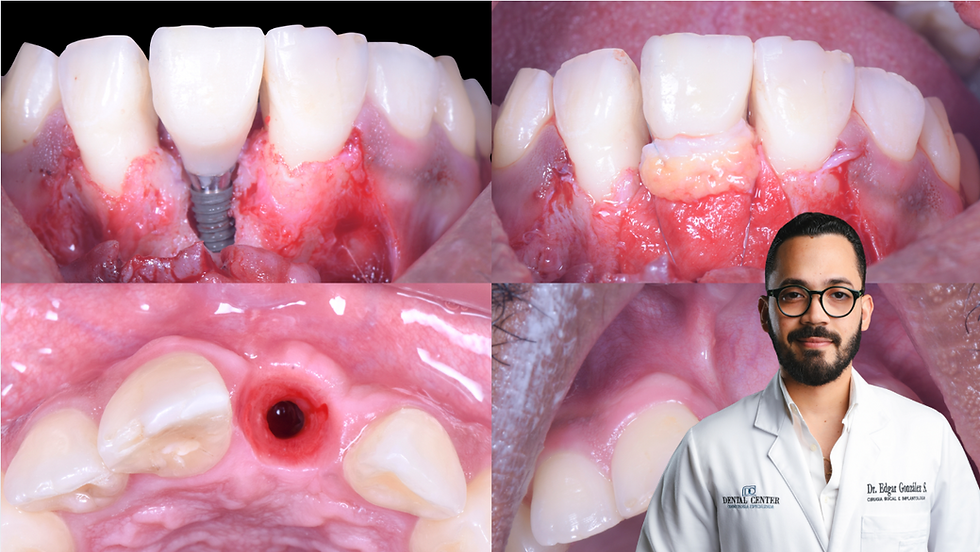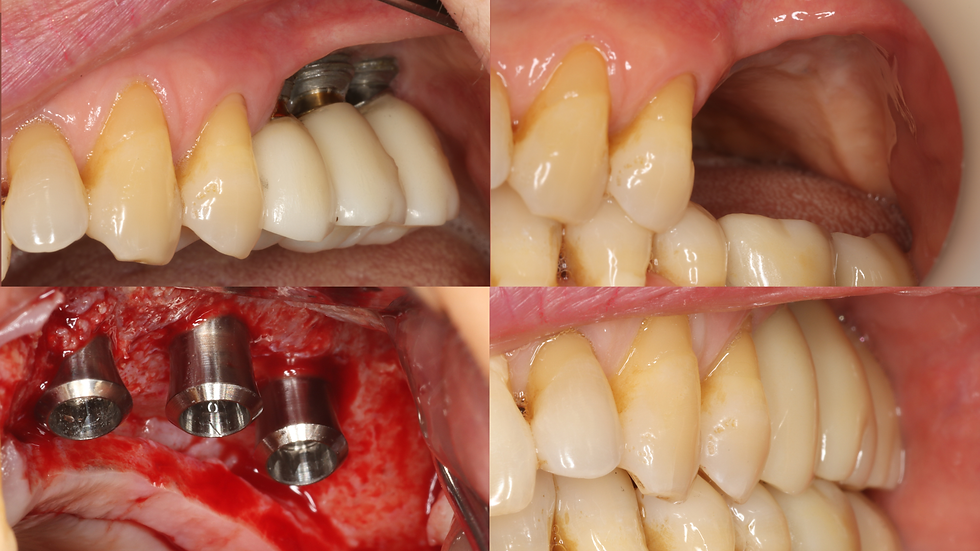Reduction Crestal-Alveoloplasty with Sinus Graft
- GAO
- Jun 27, 2017
- 4 min read
Because of downgrading of the right partially edentulous maxilla, inter-occlusal space was insufficient to restore the teeth. So some part of the residual ridge and gingiva had to be removed. However, this would leave no residual bone, and the sinus floor would be opened because the sinus floor was severely pneumatized downward. Sinus graft and crestal-alveoloplasty were performed before implant placement to create space for implant restorations. Four implants were placed only on the grafted bone, and treatment outcome was excellent.
SITUATION
In 2007, a 33-year-old, medically healthy patient presented with rampant caries. The patient returned 4 years later after many retained roots were extracted and some teeth were restored by a dentist.
Oral hygiene was still poor and there were secondary caries on the abutments of anterior teeth which needed to be restored again. Because of downgrading of the right partially edentulous maxilla, inter-occlusal space was insufficient to restore the teeth. So some part of the residual ridge and gingiva had to be removed.
However, this would leave no residual bone, and the sinus floor would be opened because the sinus floor was severely pneumatized downward.
The treatment plan was as follows:
1) Right side sinus graft with lateral approach and an 8 months waiting period for healing
2) Sinus graft and implant placement: #26, 27
3) Implant placement: #12, 35, 37, 45, 46, 47
4) Implant placement after reduction of inferior part of the residual bone
5) Restore all teeth except #41,42,43.
Sinus graft and crestal-alveoloplasty were performed before implant placement to create space for implant restorations. Four implants were placed only on the grafted bone, and treatment outcome was excellent.

Front view at first visit(2007).

On the occlusal view, rampant caries were observed.

Initial panoramic radiograph 4 years before starting the treatment. Many root rests were seen.

Clinical photograph 4 years later. Dental caries on #13 and 23 were observed due to the patient’s poor oral hygiene.
Maxillary anterior teeth also had secondary caries underneath the crowns.

Lateral view of the right side in occlusion. Because of down growth of the maxillary posterior edentulous ridge (mostly from pneumatization of the maxillary sinus) and overgrowth of mandibular posterior edentulous area, inter-occlusal clearance was insufficient for any type of restorations in the maxilla and mandible. Reduction alveoloplasty of the maxilla was planned after sinus graft.

A small vertical incision was made and the periosteum was raised so that the sinus lateral wall can be seen.

The LS-reamer was used to make a lateral hole. The reamer should be tilted side to side for depth control while the operator should watch carefully the osteotomy site. When it gets closer to the sinus membrane, the color becomes bluish or dark.

A lateral window was made in 30 seconds. In this case, the sinus membrane was exposed without a thin bony disk. If one wants to make a thin bony disk above the sinus membrane, he/ she should push the reamer a little harder during the drilling.

Using the 90 angle part of the #02 elevator, the sinus membrane on the inferior part of the lateral wall was detached.

The membrane over the sinus floor was detached with the 30 degree angle part of the #02 elevator.

Two kinds of alloplastic graft materials (DM bone made of 2cc coral and 2cc Calpore) were added to the sinus graft (Left). The lateral window was covered with a resorbable collagen membrane (Lyoplant) (Right).

Simple interrupted sutures were made along the vertical incision (Left). The incision site was completely healed in 10 days without pain and swelling (Right).

A panoramic radiograph after the sinus graft. The remaining bone height was only 1mm. The lower part of the yellow line will be cut off after 8-9 months for creating interocclusal space.

Occlusal view of left maxillary posterior area. Root rests were extracted 3 weeks previously.
A movie clip for maxillary sinus graft with the SLA kit and ACM bone and Calpore. Click on the image to see clinical video.

Panoramic radiograph after sinus graft and simultaneous implant placement. From only 1-2mm remaining bone 15 and 25 Ncm insertion torque for #26 and 27 implants, respectively, were obtained. Seven to eight months healing time was planned.

A panoramic view seven months after the sinus graft on the left side.

#26 and 27 was uncovered in seven months. Implant stabilities were measured with Ostell Mentor. ISQs were 73 and 71 for #26 and 27, respectively.

One month after the 2nd surgery.

A 3 unit-provisional restoration on implants #45, 46 and 47 was delivered to see how much inter-occlusal space was needed.

9 months after the sinus graft in the right sinus. Some part of the alveolar ridge was removed to increase interocclusal space with bone rongeur.

IS-II active fixtures were placed in the only grafted site. There was no original residual bone left.

4 implants were placed successfully. The lateral wall where the bone graft was performed was completely filled with new bone-like material. The apical area of the #14 implant had severe concavity, so a bone graft was performed.

A trephine drill was used to harvest some grafted bone in the 3rd molar area. Inset: Harvested bone with a trephine drill.
The bone density was D3~2.

The one stage approach was applied. The implant fixation was charted as ‘D322 with 40 Ncm, D333 with 25 Ncm, D334 with 25 Ncm and D334 with 25 Ncm for implant #14, 15, 16, and 17, respectively.

Panoramic view after the implants were placed in the right posterior maxilla 9 months after the graft. The crestal bone level was corrected, and the interocclusal space was secured.

A histology of the biopsy shows favorable bony remodeling around the graft material.

Buccal view of the right side. Favorable occlusal plane and interocclusal spaces were provided.

Detail of a panoramic view at delivery of the restorations.

Buccal view of the left molar area.

Detail of a panoramic view at delivery of the restorations.

Final result of the treatment. It took about 14 months to finish.

2 year follow-up panoramic x-ray reveals well maintained marginal bone levels around implants. In the maxillary right posterior area, the implants have functioned well for 2 years in spite of grafted bone only.



Comments